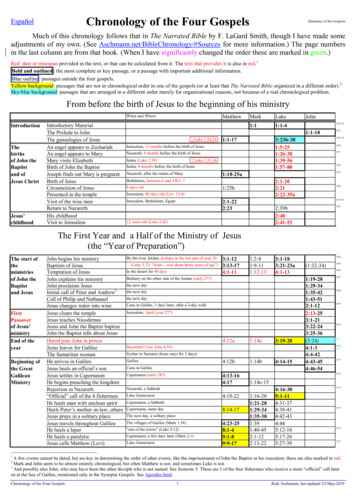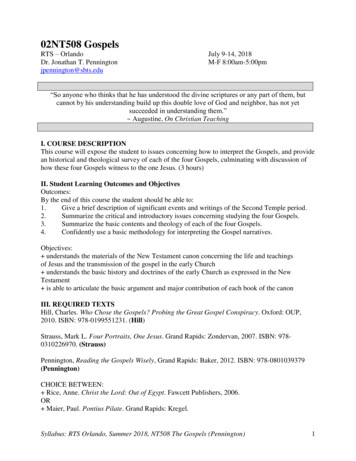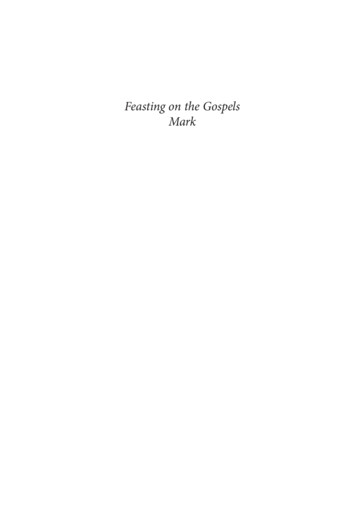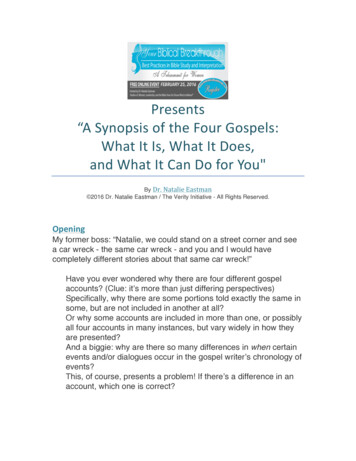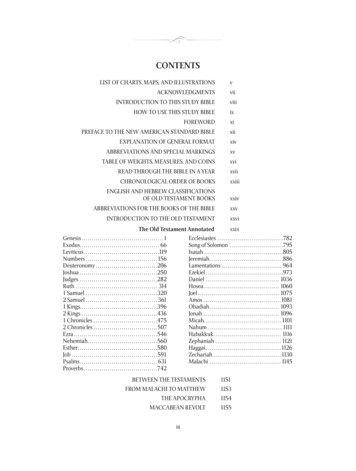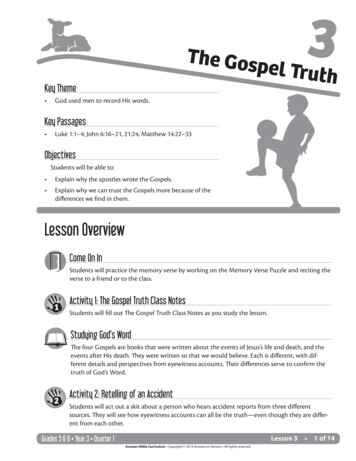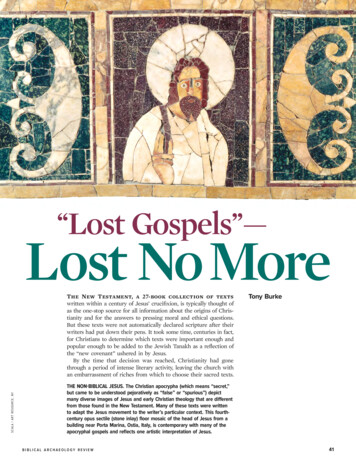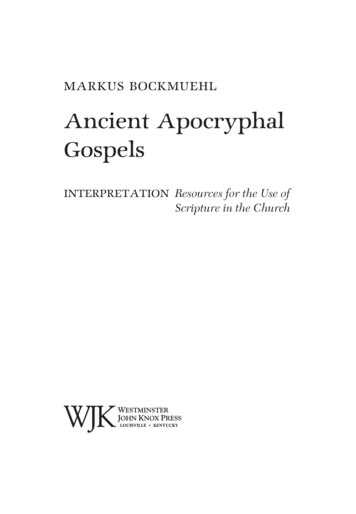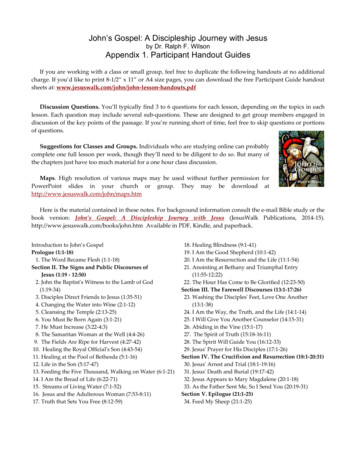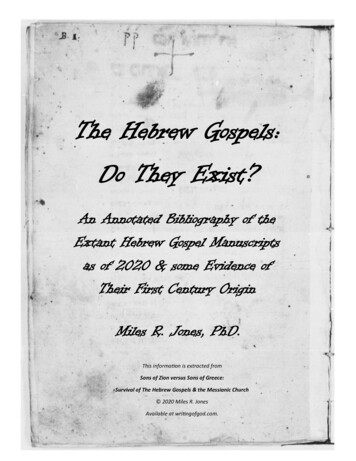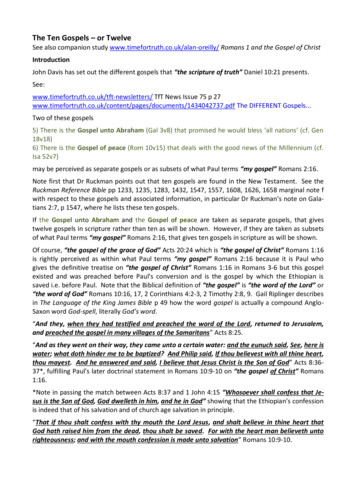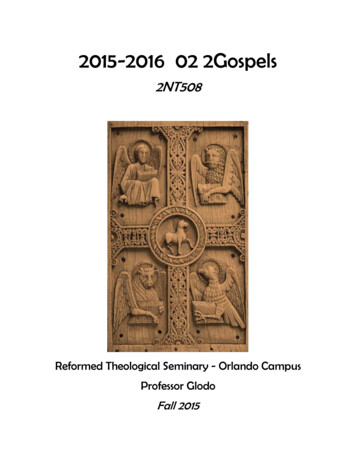
Transcription
2015-2016 02 2Gospels2NT508Reformed Theological Seminary - Orlando CampusProfessor GlodoFall 2015
Course Schedule:Wk.1DateAug 312Sep 72Sep 143421285Oct 5619726Topics (may vary)Introduction & overviewThe context of the coming of the kingdomThe concept of the kingdomAssignment Due*Getting acquainted formRidderbos ix-xxxii, 3-15No class – Labor Day HolidayThe Gospel according to MatthewThe Gospel according to Matthew, concl.The Synoptic ProblemThe Gospel according to MarkExamination 1The Gospel according to Mark, cont’d.The Gospel according to Mark, concl.Interpreting ParablesCarson & Moo 23-76, 134-168Ridderbos 18-56Carson & Moo 77-133Poythress 13-26Carson & Moo 169-197Poythress 27-76Ridderbos 61-183Interpreting MiraclesThe Quest for the Historical JesusPoythress 77-132Harmonization: Helps & HindrancesOct 12 – Spring Break – No Class Meeting8Nov 29910161123121330Dec 7Wed, Dec 9Dec 10-15*The Gospel according to LukeExamination 2The Gospel according to Luke, cont’d.The Gospel according to Luke, concl.Harmonization: Helps & HindrancesThe Jesus of the Synoptics, John and PaulThe Gospel according to JohnThe Gospel according to John, cont’d.The Gospel according to John, concl.No class – exegetical paper due at 11:00 a.m.Carson & Moo 198-224Ridderbos 184-284Poythress 133-148Poythress 157-202Carson & Moo 225-284Clowney, “Final Temple”Be sure to review the instructions for formatand means of turning in your paperExam week - Examination 3Reading schedule doesn’t include articles to be assigned from Dictionary of New Testament Background.
2NT508 – GospelsFall 2015Instructor: Associate Professor Michael GlodoOffice hours: Tuesdays 9:00-10:00 a.m., 3:00-4:00 p.m.Wednesdays 11:00 a.m.-noon; 1:00 - 2:00 p.m.Thursdays 11:00 a.m.-noonIf these hours make it difficult for you to meet with me, I will be glad to work outalternatives by appointment. During my published office hours I will be in or near myoffice or else available in one of the public campus spaces such as outside or in the bookstore. If I’m not in my office, there will be note on my door indicating where I am orJoyce will know.Contact Professor Glodo: mglodo@rts.edu, 407.278.4476information: Administrative Assistant Joyce Sisler :jsisler@rts.edu), 407.278.4552Teaching assistant: Tim Inman (tinman@rts.edu)Communication: I prefer communicating in person, but email is fine, too. If we are Facebook“friends,” please don’t use the messaging function in place of email. Pleasemake certain that my email address is on your “safe senders list” so that nocourse communications get routed to your junk mail folder.Class meeting: Mondays, 10:00 a.m.-noon, 1:00-3:00 p.m., August 31-December 7(except Labor Day, September 7 & reading week, October 12)Course web The link to course web page will be available on Canvas at least two weeksbefore the start of the semester. If you have not previously registered as apage:Canvas user, you must do so first.Course Description.Attention is given to each writer’s literary art, theological teaching, pastoral purpose, andmessage for today’s church and world. (4 hours)Getting Acquainted.If this is your first course with me, please complete the student-to-professor introduction on thecourse web page.Course Objectives.Students meeting the course objectives will have attained Knowing. A foundational knowledge of the content of the canonical gospels, including thedistinctive emphases of each gospel within its historical, cultural, literary and canonicalcontext.-i-
Gospels -ii-Fall 2015A greater apprehension of the nature of the kingdom of God as it has been inauguratedin the life, death, resurrection and ascension of Jesus Christ.An awareness of the fundamental issues in the history of gospels criticism and theircontinuing relevance for life and ministry.Greater awareness of the nature and obligations of the kingdom of God.Being. Fuller apprehension of God’s costly grace.Increased commitment to being a cross-bearing follower of Jesus Christ.Greater confidence (faith) in proclaiming the good news of the coming of the kingdomof God in Jesus Christ.Doing. Skills in analyzing passages within the canonical gospels according to their variouscontexts and particular sub-genres.Greater obedience to the call of discipleship within the kingdom of God.Course Requirements.Following is a summary of the course requirements with percentage of final grade indicated.Three examsShort-form exegesis paperTotal75% (25 % each)25Due 11:00 a.m., Wednesday, Dec 7100%Assigned ReadingThe following materials are to be read during the course. Assigned reading is subject toexamination. A reading schedule will be included in the full course syllabus.The four Gospels – Matthew, Mark, Luke and John.Carson, D. A. and Douglas J. Moo. An Introduction to the New Testament, 2nd ed. Grand Rapids:Zondervan, 2005. Pp. 23-284. ISBN 978-0310238591. 262pp.Clowney, Edmund P. “The Final Temple.” Westminster Theological Journal 35.2(1973): 156-89.(This article is available on the course web page.) 34pp.Evans, Craig, and Stanley E. Porter, eds. Dictionary of New Testament Background. DownersGrove, IL: InterVarsity, 2000. ISBN 978-0830817801. See below for articles assigned.**Poythress, Vern S. Inerrancy and the Gospels: A God-Centered Approach. Wheaton, IL: Crossway,2012. Pp. 13-148, 157-202. ISBN 978-1433528606. 181pp.Ridderbos, Herman. The Coming of the Kingdom. Phillipsburg, NJ: Presbyterian & Reformed,1962. Pp. ix-xxxii, 3-284. ISBN 978-0875524085.1 305pp.This book may be purchased as part of a Logos Bible software library. However, you should have anintentional strategy about hard copy and electronic formats. If you are considering electronic format, seeme or email me.**
Gospels-iii-Fall 2015Additional comment on readings:Carson & Moo is your basic reference work for special introduction issues and the NewTestament. It is required for all NT courses and will be a basic tool in future teaching andpreaching from the Bible.Clowney’s article is a panorama of Jesus Christ as the dwelling of God and will leave thediligent reader in doxology. It also is a direct challenge to popular eschatology in a way that isgospel-exalting and God-glorifying.Evans, or DNTB, is an expansive reference tool, this volume is part of an eight part seriescovering both Old and new Testaments. While occasionally reflecting mildly critical approachesor conclusions, it is very current and technically deep. This (and its companion volumes) is abasic component of a scholarly pastor’s library. The following articles are assigned:Read: Destruction of Jerusalem; Diaspora Judaism; Essenes; Exile; Galilee;Hasmoneans; Hellenism; Hellenistic Judaism; Herodian Dynasty; Jerusalem; JewishHistory: Judea; Jewish History: Greek Period; Jewish History: Persian Period; JewishHistory: Roman Period; Pharisees; Priests and Priesthood; Sadducees; Scribes; Temple,Jewish.Review: Alexander the Great; Art and Architecture: Jewish; Dead Sea Scrolls; Judaismand the New Testament; Messianism; Revolutionary Movements, Jewish; RomanGovernors of Palestine. “Review” means to look over the articles and read carefullythose portions which are directly relevant to Gospels study.Poythress effectively addresses many contemporary challenges to the consistency of the fourGospels on its way to providing a path to God-centered interpretation of the Gospels.Ridderbos – no other book in seminary is as profoundly enriching and under-utilized. Althoughaddressing many debates particular to the early and mid-20th state of New Testamentscholarship, Ridderbos provides a timeless snapshot of the origins and nature of the kingdom ofGod inaugurated by Jesus Christ.Schedule.The course schedule indicates for which weeks particular readings are assigned. This reading isto be completed by class on the day assigned. While the lecture pace may vary slightly from theschedule, you should keep pace with the readings as assigned since exam coverage will followthe published schedule. All assigned reading will be available either in the reserve readingsection of the Library or on the course web page.Examinations.Exams of approximately 1 ½ hours in length will be given on the dates indicated on the courseschedule. Each exam will cover the reading and lectures since the previous exam and willcontain objective (e.g. multiple choice, matching, true/false), fill in the blank and essayThe Coming of the Kingdom is also available in a downloadable pdf athttp://reformationalpublishingproject.com/pdf books/Scanned Books PDF/TheComingOfTheKingdomI.pdf. However, this classic is well worth obtaining in print form. The pdf is not searchable.1
Gospels-iv-Fall 2015questions. No notes or Bible will be permitted during the exams. On exam dates the exam willbe given in the morning and class lectures will resume after lunch. The lecture review questionsin the lecture outlines and reading review questions in this syllabus provide the basis for review.Students are welcome to work together to study for exams, but do not use shared studyquestion answers as a substitute for your own study.If English is your second language or if you have a diagnosed learning disability, you may haveadditional time on the exam if you notify me ahead of time.Short-form Exegesis PaperEach student will write an exegetical research paper on an assigned passage within the Gospels.I will give instructions during class time about the research and format required. The finalpaper will be 12-15 pages (double-spaced) in length.Paper submission instructions.Your final exegesis paper is to be submitted by email to me as an MS Word or RTF documentattachment (no PDFs). The file name should be the course name, your last name and theassignment name with dashes in-between. For example “Gospels-Glodo-Paper.” The word“Gospels” also must be in the subject line of the email.If file name does not follow these instructions, your paper will not be considered received untilyou have followed these instructions correctly.Do not email me your paper or ask me to verify if it successfully loaded to Canvas. You canverify it for yourself.Course Materials & Lecture Outlines.Lecture outlines and other handouts will be available for download from the course web page bythe start of class. For those students who request a hard copy, one will be available on one of theclass tables near the door as you enter class.Computers in Class.Computers are powerful and helpful learning tools which can also be great hindrances.Computer use is allowed in class for class purpose such as taking notes, coordinated Biblesoftware research and referencing topics which arise. Other uses are not allowed since theydegrade your attention to class, break down your ability for sustained and reflective thought,present distractions to your fellow students and don’t reciprocate to the professor the same kindattentiveness he affords you. Many students find hand writing notes the most effective way forlearning.The non-use of computers outside the above-described purposes will be enforced in class.Note Taking.Whether typing or writing notes by hand, remember that merely capturing information is notthe same thing as taking notes. While it can be good to take a lot of notes, be sure not to stoplistening while you write/type. Knowledge, in contrast to information, involves understandingthe relationships between bits of information. Critical listening requires you to understand the
Gospels-v-Fall 2015prioritization and connections of things you read and hear. The printed handouts are onlyguides to follow the lecture.Greek and Hebrew Fonts.Lecture handouts will include Greek and Hebrew materials. These are in the SBL Hebrew andSBL Greek fonts which are used by Logos Bible software and which may be downloaded for freeat aspx.Reading Review Questions.The following questions are to assist you in learning from assigned reading and are subject toinclusion on the exams. They appear alphabetically by author name, not in order of assignment.For the order of assignments, consult the course schedule above.You are permitted to work in groups to develop answers to these questions if you wish.However, they are not substitutes for doing the reading yourself.Carson & Moo 23-761. Are there doctrinal implications regarding areas of uncertainty in the New Testamentmanuscripts? (31)2. To what things does the label “biblical theology” refer? (53)3. What are the minefields we must navigate in using background material to understand theNT? (66ff.)Carson & Moo 134-1684. How does the consensus of the second century inform our view of authorship of Matthew’sGospel? (141)5. What are the two locales proposed for composition of Matthew’s Gospel? (151)Carson & Moo 169-1976. What are the three important claims of Markan authorship which emerge from Papias’statement? (173)7. What is the nature of dissent in the early church to Markan authorship? (174)8. What considerations go into concluding that Mark’s Gospel was written from Rome? (177)9. What is the “major christological purpose” of Mark’s Gospel? (194)Carson & Moo 198-22410. Considering the thematic unity and authorship of Luke and Acts, should we consider themone book or two? (203)11. What is the justification for assuming a mid-60’s AD date for the original writing of theGospel of Luke? (207-208)12. What do Carson and Moo consider the four particular contributions that Luke adds to ourunderstanding of Jesus and his mission? (219-221)
Gospels-vi-Fall 2015Carson & Moo 225-28413. What is one reason why so many mutually exclusive proposals have been made for thestructure of John’s Gospel? (226)14. How do the statements of Polycarp and Irenaeus support John the apostle as the author ofthe Gospel of John? (230)15. In what six ways do C&M summarize the relationship between John and the Synoptics?(259-64)16. What do C&M mean when they say that the purpose of John’s Gospel is not to answer thequestion “who is Jesus?”? (270-71)Clowney, “The Final Temple”17. Understand the priority of God’s presence in relation to the place of God’s presence (159).18. How is the tabernacle the gate of God as well as the dwelling of God? (160)19. What are the themes that relate Jesus to the temple in the Gospels? (167)20. Why is the relationship of Jesus to the temple not an example of spiritualizing andinterpretation? (182)Poythress 13-2621. Do we learn more or less from considering harmonization difficulties carefully?22. In dealing with harmonization difficulties, what are the three implications of being convincedthe Bible is God’s word? (15)23. What are the possibilities for explain the different versions of the healing of the centurion’sservant? (18-22)24. In the most general terms, what is the positive role of differences between synoptic accounts?(22-24, esp. conclusion on p. 24).Poythress 27-7625. How does Poythress feel about “rolling back” or minimizing the differences in synopticaccounts? (32)26. Do multiple perspectives undermine or deepen knowledge? (Why?) (34)27. Are multiple perspectives merely the result of human involvement in writing the gospels?(35)28. Are the gospels “bare facts” history? Explain. (36-37)29. List each of the five principles relevant to reading the gospels synoptically and explain whatthey mean (38-39)30. Does the theological character of John’s gospel mean it is less historical? (42)31. List and explain the five observations regarding the gospel genre. (44)32. What are Poythress’ nine principles for interpretation? (46-47)33. How can a “mental picture” approach to the Gospels both help and sometimes limit ourreading of the Gospels? (48-52)
Gospels-vii-Fall 2015Poythress 77-13234. In what two ways does persuasion concerning the nature of the Gospels come? (79)35. What two directions of “intellectual pride” does Poythress list as dangers that often troublethose who believe in the inerrancy of Scripture? (102-103)36. Would a Gospel author’s use of sources be incompatible with his writing being divinelyinspired? (118)37. What is the difference between “written order” and “chronological order” in thepresentation of events in the Gospels? (124)Poythress 133-14838. What special emphasis does John’s Gospel make in his account of Jesus cleansing theTemple? What special emphasis do Matthew and Mark make in their accounts of theTemple cleansing? (137)39. Why does Luke place the account of Jesus’ rejection at Nazareth where he does in hisnarrative? (143)Ridderbos ix-5640. Given all of the different viewpoints assessed by Ridderbos, what is his conclusion regardingthe relationship of the kingdom of God to history? (xxiii-xxiv)41. What is the decisive issue in how one understands the kingdom of God? (xxv)42. Has the kingdom of God started? (xxviii)43. What was the “exceptional and spectacular part” of John’s and Jesus’ appearance? (3)44. To what does Jesus appeal regarding the nature of the kingdom of God and his messiahship?(14)45. Which is the broader concept: kingdom, covenant or justification? (22)46. What are the ways in which the Messiah is essential to the concept of the kingdom? (28ff)47. Is time/history essential from the preaching of the kingdom? If so, in what way? (44)Ridderbos 61-10448. According to Ridderbos, what is the beginning of Jesus’ victory and of the coming of thekingdom? (63)49. What is the new and unprecedented thing about Jesus’ preaching of forgiveness in contrastto previous preachers? (74)50. Is the promised possession of the kingdom by those who would receive it from God a futureor present reality? (76)51. Jesus never explicitly refers to himself as “the Messiah.” What justification do believershave inferring this from the Gospel texts? (89-95)Ridderbos 104-18452. Did the coming and work of Jesus end the power of Satan? (110)53. How does the sending of the demons into the pigs explain the meaning of Jesus’ exorcismsin general? (113)
Gospels-viii-Fall 201554. What is the effect of Jesus speaking in parables? (125)55. How was “seeking the lost” understood in the context of the ecclesiola in ecclesia? (151)56. How is the suffering motif related to the message of the gospel? (159-160)Ridderbos 184-28457. What does a review of the Old Testament concepts behind “the poor (in spirit)” teach usabout the meaning of this phrase? (187-189)58. What was the significance of Jesus gathering a circle of twelve disciples? (198ff)59. What is the fundamental conception of redemption that distinguishes the Christian Gospelfrom other religions/world-views? (215)60. Is the concept of God’s fatherhood in Jesus’ preaching usually presented as an individual orcorporate idea? (234ff)61. What makes the “book of creation readable” according to Ridderbos? (267)
Gospels-ix-Fall 2015Course Objectives Related to MDiv* Student Learning OutcomesCourse: 2NT508 (Gospels)Professor: Michael J. GlodoCampus: OrlandoDate: Spring 2015MDiv* Student Learning OutcomesIn order to measure the success of the MDiv curriculum, RTS has definedthe following as the intended outcomes of the student learning process.Each course contributes to these overall outcomes. This rubric shows thecontribution of this course to the MDiv outcomes.Rubric Mini-JustificationStrongModerateMinimalNone*As the MDiv is the core degree at RTS, the MDiv rubric will be used in this syllabus.Articulation(oral & written)Broadly understands and articulates knowledge,both oral and written, of essential biblical,theological, historical, and cultural/globalinformation, including details, concepts, andframeworks.StrongScriptureSignificant knowledge of the original meaning ofScripture. Also, the concepts for and skill toresearch further into the original meaning ofScripture and to apply Scripture to a variety ofmodern circumstances. (Includes appropriateuse of original languages and hermeneutics; andintegrates theological, historical, andcultural/global perspectives.)Significant knowledge of Reformed theology andpractice, with emphasis on the tes a love for the Triune God thataids the student’s sanctification.StrongDesire forWorldviewBurning desire to conform all of life to the Wordof God.StrongWinsomelyReformedEmbraces a winsomely Reformed ethos.(Includes an appropriate ecumenical spirit withother Christians, especially Evangelicals; aStrongReformedTheologyModerateIn addition to writtenexaminations over lectures andreading, students must writean exegetical paper articulatingboth the method presentedand the content of thescripture passage assigned.Exegetical method is bothpresented for writing theassigned paper as well asmodel in the lectures. Issuesand principles ofharmonization address thenature of the Word of God.Relevant portions ofConfession and catechismsinserted into handouts; biblicaltheological method integratedthroughout with system ofdoctrine taught in Westminsterstandards.Classes begin each week withdevotions from the Gospels.Course material is presentedwith conviction; biblicalmaterials expounded as normfor the Christian life; supportedby examples of application tothe Christian life. The person ofChrist, who is the norm forsanctification, is the principlesubject of the course.Theology of the kingdom ofGod as revealed in Gospelsprovides orientation for life inthe now and not-yet.Alternative viewpoints withinReformed parameters as wellas those selectively outside of
GospelsPreach-xconcern to present the Gospel in a Godhonoring manner to non-Christians; and a truthin-love attitude in disagreements.)Ability to preach and teach the meaning ofScripture to both heart and mind with clarityand enthusiasm.Fall 2015it are acknowledged andexplained charitably.StrongWorshipKnowledgeable of historic and modernChristian-worship forms; and ability to constructand skill to lead a worship service.NoneShepherdAbility to shepherd the local congregation:aiding in spiritual maturity; promoting use ofgifts and callings; and encouraging a concern fornon-Christians, both in America and worldwide.ModerateChurch/WorldAbility to interact within a denominationalcontext, within the broader worldwide church,and with significant public issues.StrongBiblical content providescorpus for preaching;application provided regularlyto model application inpreaching.The character and calling of abiblical shepherd is seenthrough the life and ministry ofJesus. The coming of thekingdom of God is presentedas God’s mission in Christ andfor the church.Christ/culture paradigm arisingout of the coming of thekingdom of God used toillustrate how to relate tobroadening circles from churchto world, including the missionof God as enacted in JesusChrist.
2 Sep 14 The Gospel according to Matthew Carson & Moo 23-76, 134-168 Ridderbos 18-56 3 21 The Gospel according to Matthew, concl. Carson & Moo 77-133 . Tim Inman (tinman@rts.ed u) Communication: . ** This book may be purchased as part of a Logos Bible software library. However, you should have an .
